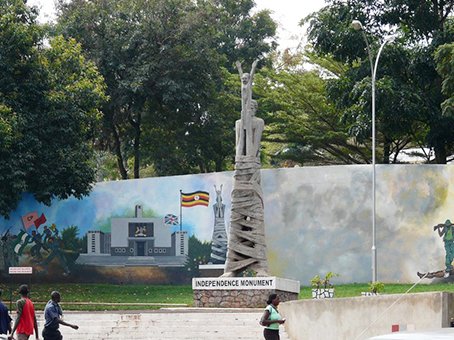
Uganda’s unique historic and natural landmarks
So much is hidden in the culture and history of a country. It is often the history of a place that shapes its present and its future. Several land marks and historic sites have been set aside to remember the history of Uganda; some abandoned and others even considered dark because of the gruesome history they hold.
Discover all the tales and legends tied to Uganda’s historic landmarks, with some dating back to the pre-colonial era with Ameera Africa Safaris. While planning your city day trips, here are some landmarks or sites that you should definitely consider visiting.
Independence monument

Standing before the independence monument, you are awe-stricken by an image of a man wrapped in cloth as he lifts a child to the sky. The statue is symbolic of a new era or generation birthed into an independent Uganda. A stop by this monument can often be incorporated into a day tour of Kampala city.
Bar-lonyo massacre grave
The Bar-lonyo massacre graves are probably the saddest historic site you could ever visit while on a Uganda Tours. They are located in northern Uganda, near Lira town in a small village known as “Barlonyo”. The site features several graves including a mass 70m long v-shaped grave that most of the locals prefer to sit on and go about their day to day activities.
When visiting northern Uganda, it would be quite the detour to reach the Bar-lonyo massacre graves. Stories are often told of a 20 year long war waged by the Lord’s Resistance Army (LRA) under Jospeh Kony and how about 500 people lost their lives. Many locals are often brought to tears while telling stories of how they watched their loved ones being beheaded, burned alive and gang raped.
Equator crossings
One of the major determinants of Uganda’s weather and climate is its location along the Equator. It is believed that this 0˚ latitude dissects the world into two equal parts; the northern and southern hemisphere. In Uganda, several cities are crossed by the equator and these points have been marked as landmarks and tourist sites.
Explore several equator crossings with Ameera Africa Safaris in special places such as Kayabwe and even Lake Victoria. At the equator point, several tests can be carried out to ascertain that indeed the equator crosses Uganda at that very point. Have a camera at the ready to capture the great moments when visiting these land marks.
Makerere University
Makerere University is Uganda’s largest and oldest institution of higher learning. It was established in 1922 as a technical school and later obtained independent national university status in 1970. Today, Makerere University is still one of the biggest in the country with nine colleges and a business school located in Nakawa.
Makerere University Business School offers about 36,000 undergraduate courses and 4,000 post graduate courses for Ugandans and foreigners every year. Visiting this ancient University on your Kampala city day trips is a great way to get acquainted with the nature of Ugandan education and how it has come to evolve over the years.
Speke monument
In a bid to discover the source of River Nile, early explorers John Hannington Speke and James Burton set sail for Africa in the early 1850’s. The journey proved rather harder than they had imagined and in the end, James Burton was bed ridden; leaving John Hannington Speke to continue the exploration on his own. He was able to discover the Source of the Nile, bursting forth from the northern tip of Lake Victoria.
A monument in his memory was erected on the western bank of the Nile, and to this very day can be seen at the source of River Nile in Jinja. Visiting this monument feels like a walk in the footsteps of the British explorer John Hannington Speke on his journey to discover the source of Africa’s longest river.
Fort-Patiko-Baker’s fort:
Fort Patiko is one of the most unvisited historic sites in Uganda. It is located about an hour from Gulu in northern Uganda. At the site large rocks stand amidst an ancient ruin of a British military base and a major slave market. Slaves from northern Uganda were gathered at Fort Patiko and the Arab slave traders would then decide their fate. The slaves would undergo critical selection and those who were deemed unfit to continue on the treacherous journey to Egypt, on foot, were massacred.
In the 1870’s, the site was seized by the British, under Sir Samuel Baker, and a military base, Fort Patiko was built. It became a base for British colonial activities under the guise to cub slave trade in northern Uganda. Visiting Baker’s fort spells a walk into a dark era of slave trade but still an important history of Uganda and her independence.
Conclusion
Uganda is a land of many mysteries and there isn’t a better way to fully immerse yourself in the culture and history of its people than with a city day trip to observe some of its unique land marks and monuments. To book a city day trip, contact us on +256- 393-194074 or send us an email today!
Leave a Reply
You must be logged in to post a comment.